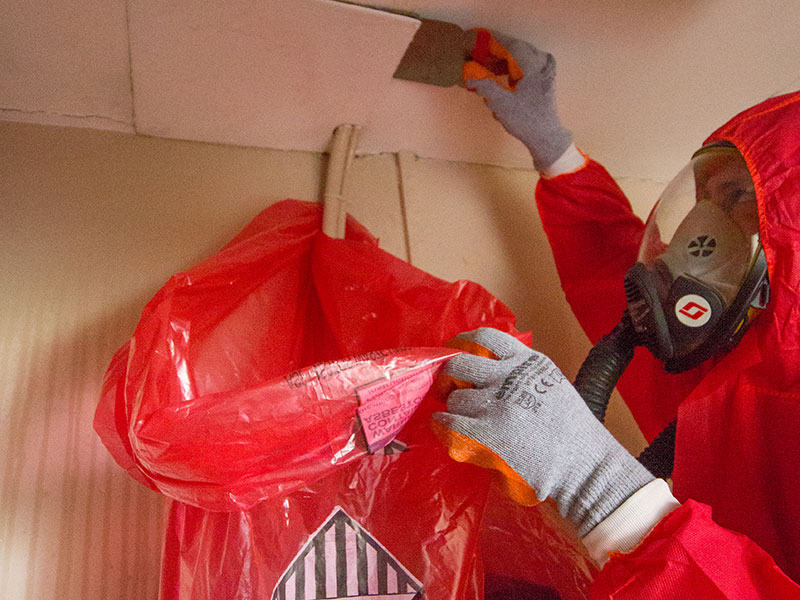Risks and challenges with asbestos removal in student accommodation in the UK
The last few decades have seen a major and sustained expansion in the numbers of people in the UK attending university. This, in turn, has helped to fuel strong demand for student accommodation up and down the country.
All of this does, however, raise some vital questions – including whether the UK’s higher-education institutions and student accommodation providers (including landlords in the private rented sector) are doing enough to protect students from the risks of asbestos.
Asbestos is a naturally occurring fibrous silicate mineral that can cause an elevated risk of certain potentially fatal diseases – such as mesothelioma and asbestos-related lung cancer – in someone who inhales or ingests it. It continues to be responsible for around 5,000 deaths a year in the UK.
Although asbestos has not been legal to use in the UK construction sector since 1999 – when all forms of it were banned – it was widely used as a construction material for the bulk of the 20th century. This means that asbestos is still present in many forms of student accommodation that were originally built prior to the year 2000.
So, it is crucial that those responsible for maintaining and repairing student accommodation buildings are aware of their duties – both moral and legal – when it comes to managing asbestos on their sites.
What is not in doubt, is that asbestos is present in many buildings that students occupy and use each and every day. A Freedom of Information (FOI) request by the law firm Stephensons Solicitors LLP found that 74% of universities in England apparently had asbestos present in the fabric of their buildings.
If, however, you are responsible for any student accommodation buildings that date from before the year 2000 – and that could therefore contain asbestos – you might not be entirely sure about the risks and challenges you would face in identifying, managing, and potentially removing such asbestos.
So, we have below taken a closer look at the key things you need to know.
Understanding asbestos and its health risks
Asbestos is the name given to a group of six different naturally occurring fibrous silicate minerals. This now-notorious substance was once commonly used throughout the UK construction sector, due to such qualities as its relative affordability, availability, physical strength, and fire resistance.
The once-positive reputation enjoyed by asbestos, led to its wholesale use in public, domestic, and commercial buildings alike up and down the UK, including in many properties that are used as student accommodation in the 2020s.
Asbestos was used for much of the 20th century, in various products that made their way into buildings, such as Artex textured ceiling coatings, insulation panels, pipe lagging, and many more.
It can hardly be too great a surprise, then, that according to a report in The Guardian in 2013, 33 out of 88 UK universities admitted that their student accommodation contained asbestos.
However, it is important to point out that the mere presence of asbestos within a university building does not necessarily indicate it to be a health risk. Indeed, asbestos is not believed to present a risk to health as long as it is in good condition and undisturbed.
In the event, however, of given asbestos-containing materials (ACMs) in a student accommodation building being disturbed or in poor condition, the health risk to occupants or users of the buildings could be severe.
What are the risks associated with asbestos in student accommodation?
With student accommodation buildings typically being so heavily accessed and used – not only by students, but also by the likes of university staff and maintenance personnel – it is crucial to be vigilant about the many ways in which asbestos risks can arise.
Asbestos was especially frequently used in the construction of student accommodation and university buildings from around the 1940s to the 1970s; this presents the risk that many ACMs still present in properties dating from the mid-20th century could now be deteriorating.
When this factor is combined with the sheer widespread use of asbestos products in such buildings, some lethal risks could result. Even such easy-to-overlook problems as broken ceiling tiles, rotten windows, and damaged roofs could pose the risk of asbestos fibres being released into the air.
If maintenance or refurbishment work is to be done on a particular building, this can also heighten the risk of ACMs being disturbed, especially if those undertaking such work have not been told beforehand about asbestos being present.
What are the challenges of asbestos removal in student accommodation?
There are certain factors that can make the tasks of managing and potentially removing asbestos from student accommodation buildings more challenging than might be the case for other types of properties in the UK.
Such buildings do, after all, tend to have high occupancy rates, with students constantly living in, and moving in and out of such properties on an everyday basis, including in order to attend lectures and socialise.
This means that the “dutyholders” for such buildings (and we will elaborate on the subject of “dutyholders” in the below section on regulations) will need to think carefully about how to manage the logistics of asbestos removal, in the event that actual removal of the materials will be needed.
It is clearly of imperative importance to cater to the health and safety of everyone who uses such properties, which may involve the removal of the asbestos, or the material instead being left in place. If the dutyholder opts to leave the asbestos in place, they must have arrangements for monitoring and managing it over time.
However, as a dutyholder, you must also balance these health and safety requirements with student welfare and accommodation needs.
So, if – for example – students will have limited access to parts of your buildings while asbestos removal takes place, you will need to consider the impact on students’ daily routines. Related to this, you will need to coordinate and communicate closely with students, accommodation providers, and contractors, in order to maximise safety while minimising disruption.
Legal obligations and regulations in the UK
There are various areas of legislation in the UK that are likely to be of relevance to student accommodation providers seeking to manage and/or remove ACMs in their buildings. These include:
- The Landlord and Tenant Act 1985, which gives a tenant the right to sue their landlord if asbestos present in the structure of the property is not maintained
- The Housing Act 2004, which enables local authorities to take action against landlords in relation to asbestos, if needed
- The Homes (Fitness for Human Habitation) Act 2018, which sets out a requirement for private rented homes to be “in repair” and “fit for human habitation”
- The Environmental Protection Act 1990, under which, the presence of asbestos in a rental property can potentially be classed as a statutory nuisance
All of the above is without even touching on the all-important Control of Asbestos Regulations 2012 (CAR 2012). These crucial regulations set out a “duty to manage” asbestos for those who manage non-domestic premises, with those who have such a duty being termed “dutyholders”.
The dutyholder is subject to certain requirements, as explained in regulation 4 of CAR 2012. They will be expected, for example, to take reasonable steps to determine whether there are materials containing asbestos in their premises – and if so, the location, amount, and condition of that asbestos.
CAR 2012 also obliges dutyholders to make (and keep up to date) a record of the location and condition of confirmed or suspected ACMs in their buildings, as well as to put together a plan setting out what will be done to manage the risks from these materials.
If you are a dutyholder for a student accommodation building, there are certain practical measures that you can adopt to help ensure you comply with all the above legislation. These include arranging an asbestos survey to enable you to determine the true asbestos situation in your property, as well as carrying out a risk assessment before any work is done on asbestos in the building.
Mitigation strategies and best practices for landlords, colleges, and universities
One of the most important things that dutyholders for student accommodation buildings can do, is ensure they hire only licensed asbestos professionals for both the surveying and removal of asbestos in their properties.
You might have read elsewhere that not all forms of asbestos removal work actually require the use of a contractor who holds a licence from the UK Health and Safety Executive (HSE). Instead, when it comes to lower-risk asbestos work, an unlicensed (but still competent) contractor can be used.
The above statement is true; however, there are very good reasons to always use a licensed contractor regardless, for asbestos surveying and removal alike.
As we have written about in the past here at Oracle Solutions, a certain asbestos removal company not having a licence can make it more difficult to ascertain their level of competence. By contrast, a licensed contractor has been deemed sufficiently competent and knowledgeable by the HSE, to be able to take on both lower-risk and higher-risk work with asbestos. Choosing to work with a licensed contractor, then, could give you invaluable peace of mind.
Certain further steps can be taken to help ensure effective and safe asbestos removal. When asbestos must be removed rather than merely contained, it will typically be necessary for the student to move out while the removal work takes place, to keep them safe from the risk of asbestos fibres being released during the removal process.
If a student does need to move out temporarily, they might be fortunate enough to be able to make their own temporary arrangements – for example, staying elsewhere with a friend until the work is done. But as this is unlikely to be the case for every student tenant you come across as a dutyholder, you should be prepared to help them find alternative temporary accommodation if required.
Whatever steps you do take, it will be crucial to ensure proper communication and education initiatives are in place for both students and staff, to help boost their own awareness of asbestos risks.
Nor should your work be over once the main asbestos removal operation has been completed. By arranging for suitable post-removal asbestos clearance testing and ongoing monitoring, you can help to ensure the given area is fit for human reoccupation, while guarding against any future asbestos risks.
Seek Oracle Solutions’ help and advice in relation to asbestos removal from your buildings
In this article, we have sought to outline the various risks and challenges in relation to asbestos removal in UK student accommodation buildings. These range from the many different asbestos products that can be found in such properties, to the importance of achieving the utmost safety and minimal disruption with your asbestos removal strategies.
By taking proactive steps to manage the asbestos risks that your student accommodation might present if you are a “dutyholder”, while remaining in compliance with the relevant regulations, you can help to ensure efficient asbestos removal, alongside the greatest possible student safety and wellbeing.
Would you like to learn more about the advice and support that Oracle Solutions can provide as you seek to take all the necessary steps in managing any confirmed or suspected asbestos on your site? If so, you are very welcome to give us a call or to send us an email, to request your free asbestos quote.

Written by Callum McDonald
Callum McDonald is an expert in asbestos quality management, ensuring rigorous adherence to regulations and high-quality standards in removal projects. His focus on enhancing quality and client satisfaction makes him a crucial asset in safety and compliance within the field. Callum's expertise in technical support and oversight of licensed works underscores his commitment to excellence in asbestos management, providing invaluable guidance to clients in this specialised area.

